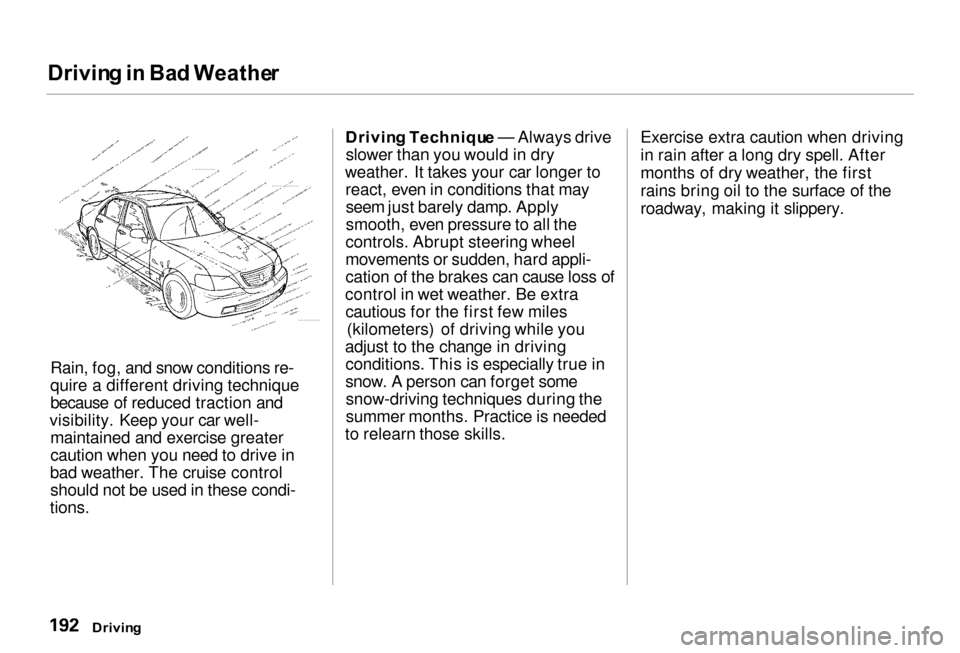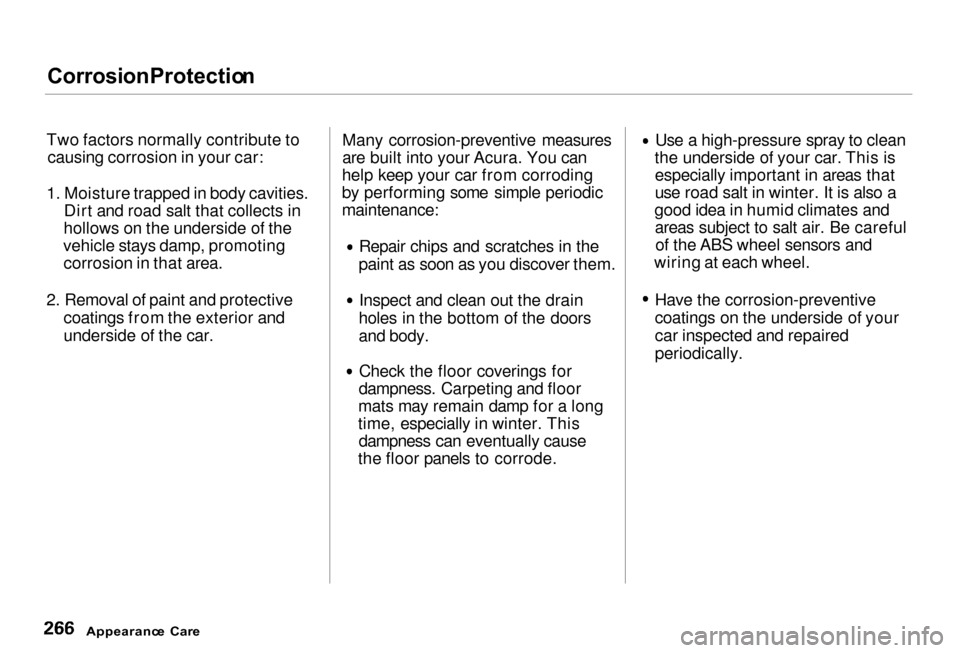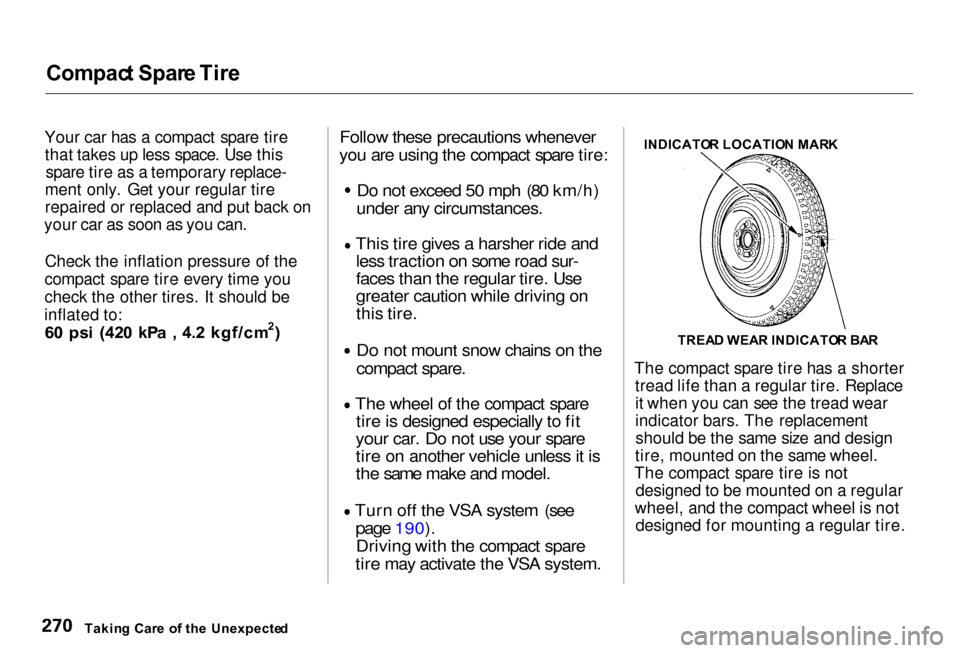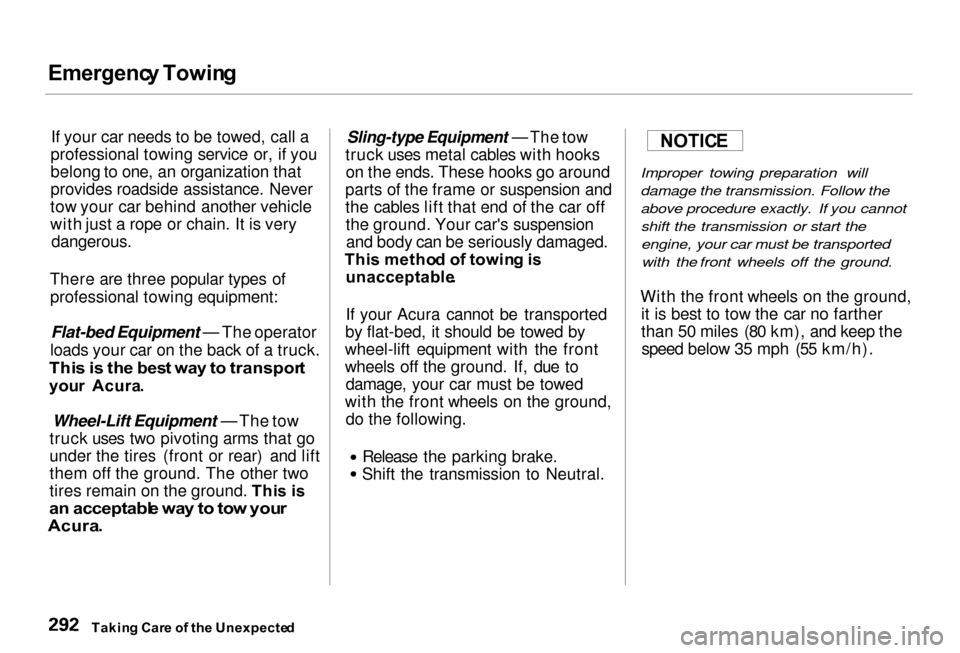ESP Acura RL 2000 3.5 User Guide
[x] Cancel search | Manufacturer: ACURA, Model Year: 2000, Model line: RL, Model: Acura RL 2000Pages: 330, PDF Size: 4.53 MB
Page 192 of 330

Vehicl
e Stabilit y Assis t (VSA ) Syste m
The Vehicle Stability Assist system helps to stabilize the vehicle duringcornering if the car turns more or
less than desired. It also assists you
in maintaining traction while
accelerating on loose or slippery
road surfaces. It does this by
regulating the engine's output, and
by selectively applying braking.
When VSA activates, you may notice that the engine does not respond to
the accelerator in the same way itdoes at other times. You will also see
the VSA Activation Indicator blink.
For a technical description of the
Vehicle Stability Assist System, see
page 300.
The VSA system cannot enhance the
car's driving stability in all situations
and does not control your vehicle's
entire braking system. It is still your
responsibility to drive and corner at
reasonable speeds and to leave a sufficient margin of safety. VSA Activation Indicator
VSA ACTIVATIO N INDICATO R
When VSA activates, you will see the VSA Activation indicator blink.
CONTINUED
Drivin g
Page 195 of 330

Drivin
g in Ba d Weathe r
Rain, fog, and snow conditions re-
quire a different driving technique
because of reduced traction and
visibility. Keep your car well- maintained and exercise greater
caution when you need to drive in
bad weather. The cruise control should not be used in these condi-
tions. Drivin
g Techniqu e — Always drive
slower than you would in dry
weather. It takes your car longer to react, even in conditions that mayseem just barely damp. Apply
smooth, even pressure to all the
controls. Abrupt steering wheel
movements or sudden, hard appli-
cation of the brakes can cause loss of
control in wet weather. Be extra cautious for the first few miles (kilometers) of driving while you
adjust to the change in driving conditions. This is especially true in
snow. A person can forget somesnow-driving techniques during the
summer months. Practice is needed
to relearn those skills. Exercise extra caution when driving
in rain after a long dry spell. After
months of dry weather, the first
rains bring oil to the surface of the
roadway, making it slippery.
Drivin g
Page 265 of 330

Exterio
r Car e
Washin g
Frequent washing helps preserve
your car's beauty. Dirt and grit can scratch the paint, while tree sap and
bird droppings can permanently ruin the finish.
Wash your car in a shady area, not in direct sunlight. If the car is parked in
the sun, move it into the shade and
let the exterior cool down before you start.
Only use the solvents and cleaners
recommended in this Owner's
Manual.
Chemical solvents and strong cleaners
can damage the paint, metal, and
plastic on your car.
Rinse the car thoroughly with cool
water to remove loose dirt. Fill a bucket with cool water. Mix
in a mild detergent, such as
dishwashing liquid or a product
made especially for car washing. Wash the car using the water and
detergent solution and a soft-
bristle brush, sponge, or soft cloth. Start at the top and work your waydown. Rinse frequently. Check the body for road tar, tree
sap, etc. Remove these stains with
tar remover or turpentine. Rinse it off immediately so it does not
harm the finish. Remember to re-
wax these areas, even if the rest of
the car does not need waxing. When you have washed and rinsed
the whole exterior, dry it with achamois or soft towel. Letting it
air-dry will cause dulling and water
spots.
As you dry the car, inspect it for chips and scratches that could allow
corrosion to start. Repair them with
touch-up paint (see page 263 ).
Appearanc e Car e
NOTIC
E
Page 269 of 330

Corrosion
Protectio n
Two factors normally contribute to causing corrosion in your car:
1. Moisture trapped in body cavities. Dirt and road salt that collects in
hollows on the underside of the
vehicle stays damp, promoting corrosion in that area.
2. Removal of paint and protective coatings from the exterior and
underside of the car. Many corrosion-preventive measures
are built into your Acura. You can
help keep your car from corroding
by performing some simple periodic
maintenance:
Repair chips and scratches in the
paint as soon as you discover them. Inspect and clean out the drain
holes in the bottom of the doors
and body. Check the floor coverings for
dampness. Carpeting and floor
mats may remain damp for a long
time, especially in winter. This dampness can eventually cause
the floor panels to corrode. Use a high-pressure spray to clean
the underside of your car. This is especially important in areas that
use road salt in winter. It is also a
good idea in humid climates and areas subject to salt air. Be carefulof the ABS wheel sensors and
wiring at each wheel. Have the corrosion-preventive
coatings on the underside of your
car inspected and repaired
periodically.
Appearanc e Car e
Page 273 of 330

Compac
t Spar e Tir e
Your car has a compact spare tire that takes up less space. Use this spare tire as a temporary replace-
ment only. Get your regular tire
repaired or replaced and put back on
your car as soon as you can.
Check the inflation pressure of the
compact spare tire every time you
check the other tires. It should be
inflated to:6 0 ps i (42 0 kP a , 4. 2 kgf/cm 2)
Follow these precautions whenever
you are using the compact spare tire: Do not exceed 50 mph (80 km/h)
under any circumstances.
This tire gives a harsher ride and less traction on some road sur-
faces than the regular tire. Use
greater caution while driving on
this tire. Do not mount snow chains on the
compact spare.
The wheel of the compact spare
tire is designed especially to fit
your car. Do not use your spare
tire on another vehicle unless it is
the same make and model.
Turn off the VSA system (see page 190).Driving with the compact spare
tire may activate the VSA system.
The compact spare tire has a shorter
tread life than a regular tire. Replace
it when you can see the tread wear
indicator bars. The replacementshould be the same size and design
tire, mounted on the same wheel.
The compact spare tire is not designed to be mounted on a regular
wheel, and the compact wheel is not designed for mounting a regular tire.
Takin g Car e o f th e Unexpecte d INDICATO
R LOCATIO N MAR K
TREA D WEA R INDICATO R BA R
Page 295 of 330

Emergenc
y Towin g
If your car needs to be towed, call a
professional towing service or, if you
belong to one, an organization that
provides roadside assistance. Never
tow your car behind another vehicle
with just a rope or chain. It is very
dangerous.
There are three popular types of professional towing equipment:
Flat-bed Equipment — The operator
loads your car on the back of a truck.
Thi s is th e bes t wa y to transpor t
you r Acura .
Wheel-Lift Equipment — The tow
truck uses two pivoting arms that go
under the tires (front or rear) and lift
them off the ground. The other two
tires remain on the ground. Thi s i s
a n acceptabl e wa y to to w you r
Acura .
Sling-type Equipment — The tow
truck uses metal cables with hooks on the ends. These hooks go around
parts of the frame or suspension and
the cables lift that end of the car off the ground. Your car's suspensionand body can be seriously damaged.
Thi s metho d o f towin g is
unacceptable .
If your Acura cannot be transported
by flat-bed, it should be towed by
wheel-lift equipment with the front
wheels off the ground. If, due to damage, your car must be towed
with the front wheels on the ground, do the following. Release the parking brake.
Shift the transmission to Neutral.
Improper towing preparation will
damage the transmission. Follow the
above procedure exactly. If you cannot
shift the transmission or start theengine, your car must be transportedwith the front wheels off the ground.
With the front wheels on the ground, it is best to tow the car no farther
than 50 miles (80 km), and keep thespeed below 35 mph (55 km/h).
Takin g Car e o f th e Unexpecte d
NOTIC
E
Page 303 of 330

Vehicl
e Stabilit y Assis t (VSA ) Syste m
The Vehicle Stability Assist system (VSA) monitors the car's actions
during straight-line acceleration and
cornering behavior. It reduces
engine power and applies selective
braking if it senses any loss of
traction.
Controllin g Tractio n Durin g
Straight-lin e Acceleratio n
If one drive wheel is turning faster
than the other, or both drive wheels
are turning faster than the non- driven wheels, VSA senses
wheelspin. It reduces engine power and applies braking at the wheels as
necessary to increase traction.
To do this, VSA monitors the pulse frequencies from the wheel speed sensors. It also uses information
from the steering wheel angle sensor
and the lateral acceleration sensor to determine if the car is accelerating in
a straight line or if it is cornering.
VSA can then calculate how much wheelspin, if any, to allow. It signals
the ECU to reduce fuel flow andretard ignition timing. This reduces
available engine power. The ECU
will also apply braking at the wheels as necessary. When wheelspin has
been controlled, braking and engine
control return to normal.
Controllin g Tractio n Durin g
Cornerin g
VSA monitors steering input and the car's expected response to that input.
VSA's yaw rate sensor measures the car's actual cornering behavior. If VSA determines that the car is
turning more or less than expected,
the system reduces engine power
and applies braking at the
appropriate wheel to try and
maintain adequate traction during
cornering.
VSA uses the same wheel speed sensor assemblies as the ABS.
Additional sensors measure steering wheel angle, lateral acceleration, and
yaw rate.
The control unit monitors the VSA circuitry while driving. If it senses a
problem, it turns off the system and illuminates the VSA System
Indicator on the instrument panel.
Technica l Informatio n
Page 305 of 330

DO
T Tir e Qualit y Gradin g (U.S . Cars )
Temperatur e
The temperature grades are A (the highest), B, and C, representing the
tire's resistance to the generation of
heat and its ability to dissipate heat when tested under controlledconditions on a specified indoor
laboratory test wheel. Sustained high
temperature can cause the material of the tire to degenerate and reduce
tire life, and excessive temperature can lead to sudden tire failure. The
grade C corresponds to a level of performance which all passenger car
tires must meet under the Federal Motor Vehicle Safety Standard No. 109. Grades B and A represent
higher levels of performance on the
laboratory test wheel than the
minimum required by law. Warning: The temperature grade for
this tire is established for a tire that
is properly inflated and not over-
loaded. Excessive speed, underinfla-
tion, or excessive loading eitherseparately or in combination, can
cause heat build-up and possible tire
failure.
Technica l Informatio n